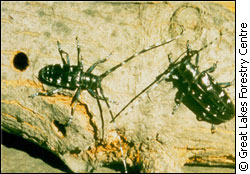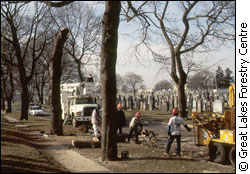| Tracking
a tiny
but deadly menace
By David Baeta
OTTAWA —
A ruthless killer is lurking
in Canada's forests, but, unlike most criminals, this
one's hard to trace and contain — that's because
it's about one inch long.
The perpetrator is an insect called
the Asian Longhorn beetle and it kills Canadian trees
without mercy.
Trunks
and branches of healthy trees are first to feel the
wrath of this beetle as it tunnels through the bark,
nestles in the hardwood, and eventually kill its host.
 |
| Scientists found a way to
identify the Asian Longhorn beetle using its DNA—even
if the beetle is in its larval or adult stage. |
There are currently no detection procedures
to track this beetle down, however the Canadian Forest
Service (CFS) have scientists working on the case.
Dr. Arthur Retnakaran is one of the scientists.
His study was recently published in the journal
Archives of Insect Biochemistry and Physiology.
In essence, he has developed molecular markers for detecting
not only the Asian Longhorn beetle but the Brown Spruce
budworm and other allied invasive species. In other
words, he found a way to detect the Asian Longhorn beetle
using its DNA sequence—much like it is done in
criminal investigations involving humans.
Ladies and gentleman: the beetle!
| "The beetle
has no predators to control its here. It's a perfect
ecological match." |
The black beetle sports white spots, a
shiny shell, and a distinguishable antenna banded with
black and white lines.
With the capacity to fly distances covering
three city blocks, the beetle poses an even more serious
threat to Canada's 420 million hectares of forest.
" Anything that can fly will be beneficial to the
insect's propagation, as it makes it easier for it to
move," says Dr. David MacLean, Dean of Forestry
at the University of New Brunswick.
The beetle was accidentally introduced
to Canada because it was lodged in wood used to make
packing crates; it is originally from China and the
Korean peninsula.
Once in Canada, the beetle found the perfect milieu
where it could quickly wreak havoc. "It came from
Northern China, where there are very similar conditions,"
says Dr. Retnakaran. "It has no predators to control
them here. It's a perfect ecological match."
More specifically, it's the beetle's one-year life cycle
that is damaging to trees. The cycle begins with the
female beetle chewing holes in the bark of trees—called
oviposition sites—to lay eggs. Within 10 to 15
days, the worm-like larvae tunnel under the tree bark
and bore into healthy hardwood trees.
"Once they've hatched, the larvae will eat all
the wood behind the bark to stay alive until they come
out," says Dr. Retnakaran.
The larvae feed on wood during the fall and winter and
emerge through exit holes in the spring. Now adult,
the beetle feeds on tree exteriors for two to three
days, then mate –restarting the cycle. The adult
beetle remains active only during summer and early fall
months before dying.
Tracking the unknown
A publication on invasive species by the
CFS says the beetle could be quite damaging for Canada's
forests if an epidemic occurred. Since the beetle loves
maple trees, CFS claims it would be particularly damaging
to the maple industry, which is worth $100 million annually.
 |
| Once the beetle has struck,
the only way to save neighbouring trees is to completely
destroy them. |
The only existing solution to remedy the
problem is to destroy infected trees. That's why Dr.
Retnakaran says it is important to track this deadly
killer before it does extensive damage.
Usually, invasive species are identified
by the appearance of the adult insect, says Dr. Retnakaran.
But that's not possible with insects.
"If I was a larva it would be harder to detect
and define who I was in comparison to other larvae around
me," says Dr. Retnakaran. Physically, they are
all very similar; this is where DNA comes in. "They
[CFS] wanted us to design a DNA system to detect the
beetle, much like the ones used in forensics."
During crime scene investigations, criminals
are often identified using their DNA sequence. DNA consists
of two long chains of nucleotides twisted into a double
helix and joined by hydrogen bonds. In other words,
DNA is an imprint of the characteristics of an individual.
From humans to insects
The DNA extraction is very efficient in
a crime scene involving humans, but when you're talking
about insects things are a little different. In essence,
Dr. Retnakaran wants to transpose DNA fingerprinting
to the world of insects. However, this is problematic
because the beetle's genome is unknown.
| 'With the capacity
to fly distances covering three city blocks, the
beetle poses an even more serious threat to Canada's
420 million hectares of forest.' |
Dr. Retnakaran says that his study has
solved this problem. He has identified genetic markers
that can be used to distinguish the beetle from other
closely related insects — without knowing the
full genome.
Dr. Retnakaran says that, typically, when
you don't know the genome of what you are studying you
will use primers to analyse it. "Primers are small,
random pieces of DNA, which are manufactured to stand
out when the sequence is extracted," says Retnakaran.
Primers are combined to a single strand
of DNA and they will force added-enzymes to synthesise
a combination of matching bases on the DNA strand when
it replicates itself.
Once that's done, the strand is an identical
duplicate of the first DNA strand.
Using a procedure called electrophoresis,
the size of DNA molecules and their respective primers
can be established. During this procedure, which is
comparable to sieving methods used to find gold, DNA
will be placed in a gel-like substance similar to Jell-O.
Containing the pest
Dr. Retnakaran is not using electrophoresis
to find gold. He uses it to establish a positive match
between the DNA sample and the culprit. The size of
the molecule and the primers he inserted in the sequence,
help him to unambiguously make a link between the sample
and culprit — just like in a crime scene investigation.
Dr. Retnakaran says this
will help save millions of trees in Canada.
Right now, when a tree is infested, blanket
measures are used to eliminate the beetle. In essence,
all the trees in a given radius will be cut, chipped,
and burned.
"From an ecological standpoint, they
can be as damaging as a wild forest fire," MacLean
says of the potential damage of insect outbreaks.
Thanks to Dr. Retnakaran's
molecular markers, field workers will be able quickly
and reliably identify where the beetle has struck —
at the same time saving countless trees.
|
|
DNA consists of two
long chains of nucleotides twisted into a double
helix and joined by hydrogen bonds. The sequence
of nucleotides determines individual hereditary
characteristics.
DNA is an imprint of the characteristics
of an individual encoded in the cell. This sequence
can be extracted from any cell from the individual
and read. Blood, hair, and skin samples are commonly
used.
Dr. George Carmody, an adjunct professor
of biology at Carleton University, says that in
the case of a sexual assault we could use semen
deposited at the scene to establish the identity
of an assailant. "Typically, you would use
the semen as evidence by extracting DNA from it."
To extract DNA "you begin
by treating the sample from which you want to
extract the DNA in a solution," says Carmody.
The solution contains "an enzyme that breaks
down the DNA protein." This solution will
essentially cut the two long strands of DNA, resulting
in two single, separate strands.
Then, an organic extraction is done.
This is where "any of the lipids in the solution
are extracted using formaldehyde and ether,"
says Carmody. In other words all the organic elements
are removed from the solution.
At this point, "you let the
test tube stand," says Carmody. "The
organic solvents rise to the surface and the DNA
remains at the bottom."
This is reminiscent of oil and water.
When mixed, the oil, which is made of smaller
molecules than water, will rise to the top and
the water will settle to the bottom.
Once you take the oil layer away,
the water contains what you need.
"The DNA is now dissolved in
the water solution," says Carmody. "You
can take the DNA out using an ethanol and alcohol
mix. The DNA precipitates out, and you then put
it in a centrifugal machine."
After that, the DNA is washed with
fresh water and a standard kit sold by manufacturers
is used to figure out the size and characteristics
of each DNA molecule.
|
|